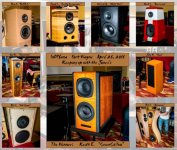Is it realistic to design a bookshelf (or even a tower) with down facing subwoofer (6 or 8") that can do 30Hz and on the top would be just one concentric driver for high and midrange.
I don't have much knowledge in this regard. 🙂
I don't have much knowledge in this regard. 🙂
Yes is the answer. The more the members help you with this, the better the result will be. You need to tell us more about the restrictions before we can help.
I assume the drivers and parts wound be in the sub 500 range? And the subwoofer should not cause the bookshelf to be too large, at that point it would just be a tower design. I don't mind them being a 4 ohm speaker.
What do you mean by "tower" - a "tower" is usually a floor standing speakers. I suggest you do a very raw sketch with paper and pen, set some largest possible dimensions, take a photo and post it here - this will help understanding your ide'.
//
//
I think way back in the 1980s or early 1990s PSB (?) made some chunky bookshelf speakers that had a downfiring woofer, and front firing (spearate, not coaxial) midrange and tweeter. The speaker consisted of a base, and a box that was elevated above it slightly, with the downfiring woofer firing into the space in between. In this way it could be placed in bookshelf and surrounded by books, and would still function.
There are a couple of points to consider. The downfiring driver will play into a slot, and slots create quarter wave resonances that cause peaks and dips. Typically you would want to cross over by e.g. 200Hz to the midrange to avoid these response features, but that would depend on whether the midrange can cross that low.
If instead of a flat bottom and slot, if you make the cabinet a little taller you can angle the bottom to create an opening that is more like a wedge, e.g. angled up by 30-45 degrees. This significantly reduces (but does not completely eliminate) the resonances I mentioned. But they may be small enough to not worry about, so this is probably the best approach and it would allow you to raise the crossover point to the mid.
You can also make a tower, but you will then need to pay more attention to how far apart the woofer (bottom) and midrage (higher up) are separated with respect to the wavelength of sound at the crossover frequency. The sound will travel farther from the woofer to the listener (along a hypotenuse) compared to straight at the listener for the mid/tweeter. This causes a delay, which is the same as a phase rotation, and you will need to pay attention to that at the crossover point so that sounds arrive in phase or close to it.
There are a couple of points to consider. The downfiring driver will play into a slot, and slots create quarter wave resonances that cause peaks and dips. Typically you would want to cross over by e.g. 200Hz to the midrange to avoid these response features, but that would depend on whether the midrange can cross that low.
If instead of a flat bottom and slot, if you make the cabinet a little taller you can angle the bottom to create an opening that is more like a wedge, e.g. angled up by 30-45 degrees. This significantly reduces (but does not completely eliminate) the resonances I mentioned. But they may be small enough to not worry about, so this is probably the best approach and it would allow you to raise the crossover point to the mid.
You can also make a tower, but you will then need to pay more attention to how far apart the woofer (bottom) and midrage (higher up) are separated with respect to the wavelength of sound at the crossover frequency. The sound will travel farther from the woofer to the listener (along a hypotenuse) compared to straight at the listener for the mid/tweeter. This causes a delay, which is the same as a phase rotation, and you will need to pay attention to that at the crossover point so that sounds arrive in phase or close to it.
Last edited:
That's what I meant. Floor standing.
Perhaps you should ask moderators to change a title. Your title says 'bookshelf', yet you mean floor standing.
Yes, when I created the post, my intention was bookshelf and the reason to mention floor standing is if the bookshelf with a subwoofer is impractical to achieve with good results, then I would be open to doing floor standing because it would add extra volume needed by both the mid range and the subwoofer. Sorry for any confusion.
the bookshelf with a subwoofer is impractical to achieve with good results,
since when?
- Home
- Loudspeakers
- Multi-Way
- Concentric driver with down facing 6" subwoofer in a bookshelf possible?
